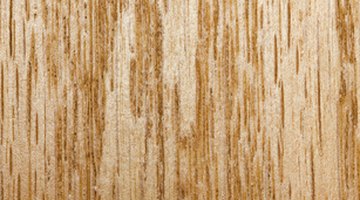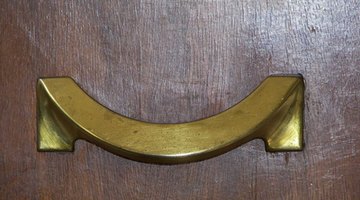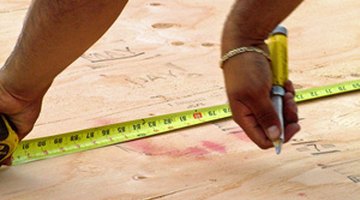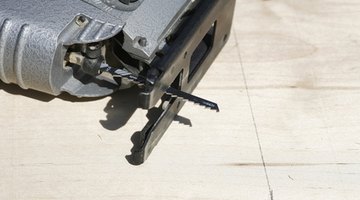How to Skirt a Mobile Home With Wood
Skirting a mobile home can result in lower utility bills. It helps eliminate drafts and prevents frozen pipes. You can create a beautiful oak skirting look, or paint it to match the home's exterior. Make your mobile home more energy efficient and keep out animal pests by making your own mobile home skirt.

Set aside a full day for the job. It's much easier to do and goes faster with a helper, and having two helpers is even better.
Things You Will Need
- 150 feet of trailer skirting trim or 20, 1-by-4-inch by 8 feet long boards
- Box of 3-inch long wood screws
- Cordless drill and screwdriver bits
- One or two helpers
- Measuring tape
- Pencil
- 20 Sheets of exterior grade, weather-resistant plywood
- Chalk line
- Circular saw
- Sandpaper
- Box of 1-inch wood screws
- 84 flat brackets (also called mending brackets)
- 8, 2-inch wide corner braces
- 1, 1-by-4-inch by 8 feet long board
- Straightedge
- 2 Large drawer handles and accompanying screws
- Sabersaw
- 6 Metal air vents and accompanying screws
- Wood stain or paint
- Paint brushes
- Waterproofer for wood
-
Install skirting trim according to manufacturer's instructions, or make your own. If making your own, use wood screws to attach long boards, such as 1-by-4-inch boards, to the bottom of the mobile home, leaving at least a 1-inch overhang at the bottom. The skirting will go behind this overhang, and will be secured to it. If you have two helpers, have them start attaching the skirting trim while you do step 2.
-
Decide where you want to locate your access panel. It's important to have access to the underside of the mobile home to make plumbing or other repairs. It also creates storage space under the trailer for storing out of season items and tools. The access panel will be a 4-foot wide section, and ideally should be placed near the utility hookups.
-
Locate the spot just to the right of where you're going to place the access panel. Measure and record the distance between the bottom of the mobile home and the ground at that point. If the wood you are using is 4-feet wide, measure 4 feet from that point and take another trailer-to-ground measurement. If you're using a different width board, take your measurements at the appropriate distance so that you know the height the skirting will need to be on the left and right sides of the board.
-
Mark the measurements on a piece of plywood, or other wood if you wish to use another kind of wood for the skirting. If the ground is soft, add 1/2 inch to the measurements. If the trailer is on a concrete slab or if the ground is very firm, do not add the extra 1/2 inch. Measure and mark the height that the left side of the board needs to be, and the distance that the right side of the board needs to be.
-
Snap a chalk line across the panel between these two marks. This is the cut line.
-
Use the circular saw to cut the piece of plywood just to the outside of the cut line, leaving a bit of the chalk line. Remove any large splinters, but it's not necessary to sand the board smooth.
-
Slide the board under the trailer at an angle and place it forward against the trim. Hold the plywood skirting panel firmly against the trim and use the cordless drill to drive a 1-inch wood screw through the trim and into the plywood skirting panel. Place a screw every 12 to 18 inches along the span of the skirting board.
-
Install the next panel of skirting in the same way. Take two flat brackets (also called mending brackets) the 1/2-inch long wood screws, and the cordless drill, and crawl under the mobile home, feet first. Facing out, attach the two panels to each other using the flat brackets. Place a bracket about one-third of the way down the panels, using the 1/2-inch wood screws. Take care not to drive the screws all the way through the board. Place another flat bracket about one-third of the way from the bottom of the panels, so that the brackets are evenly spaced.
-
Continue placing skirting panels and flat brackets all the way around the mobile home's perimeter. At the corners, use 2-inch wide corner braces to attach the panels on either side of the corner to each other, in the same manner as you attached the flat brackets.
-
Proceed to install skirting panels until you reach the point where the access panel is going to be placed, meaning a distance of 4 feet or shorter. Measure the distance between the last panel you just placed and the first panel that you placed. If the distance is shorter than 4 feet, decide whether you want the access panel to be shorter than 4 feet, or if you want to remove and trim the last panel you just placed.
-
Make the frame for the access panel by cutting and attaching 1-by-4-inch boards vertically to the inside of the trailer skirting panels on either side to make posts. Place one of these boards on each side of the place where the access panel is going to be attached, leaving half of the board exposed so that when the panel is in place, the panel will rest against the boards. Drive three 1-inch screws per board through the front of the skirting panel and into the 1-by-4 inch vertical post.
-
If the width of the space is less than the width of the plywood sheet, cut the board to fit the space. Measure from the bottom of the overhanging skirting trim to the ground on the left side of the space, and on the right side of the space. Mark and cut the plywood as you did the other panels.
-
Attach two drawer handles to the access panel with the accompanying screws. Space them about shoulder width apart, for ease of use. Place the access panel up against the frame, and drive one screw in each corner of the access panel, through the front of the access panel and into the frame. Anytime you need to access the underside of the mobile home, just remove these screws, pull on the handles and remove the panel. The skirting is now ready to be painted or stained as desired. Finish with a waterproofer. Follow manufacturer's instructions and allow to dry.
-
Use a saber saw to cut vents in six underpinning panels spaced evenly around the mobile home. Sand away any large splinters. Insert the metal vents and screw into place to secure. The vents ensure that your heating and air conditioning unit has an adequate air supply.




Tip
Instructions are based on a 14-by-60 mobile home, and also will work for a 16-by-60. For other sizes, just adjust the number of flat brackets and sheets of plywood accordingly.
Warning
If you're in a wet climate, cover the bottoms of the panels with split rubber tubing to prevent water from wicking up the wood to the home. Use protective eyewear when using power tools. You may wish to wear a hardhat; watch head clearance when under the trailer. In the case of an impending storm that would create the need to tie down the mobile home, remove a few skirting panels to do so.
The Drip Cap
- Skirting a mobile home can result in lower utility bills.
- It helps eliminate drafts and prevents frozen pipes.
- Make your mobile home more energy efficient and keep out animal pests by making your own mobile home skirt.
- Measure and record the distance between the bottom of the mobile home and the ground at that point.
- Hold the plywood skirting panel firmly against the trim and use the cordless drill to drive a 1-inch wood screw through the trim and into the plywood skirting panel.
- Place a screw every 12 to 18 inches along the span of the skirting board.
- Place a bracket about one-third of the way down the panels, using the 1/2-inch wood screws.
- If the distance is shorter than 4 feet, decide whether you want the access panel to be shorter than 4 feet, or if you want to remove and trim the last panel you just placed.
- If the width of the space is less than the width of the plywood sheet, cut the board to fit the space.
- Use a saber saw to cut vents in six underpinning panels spaced evenly around the mobile home.
- Sand away any large splinters.
- The vents ensure that your heating and air conditioning unit has an adequate air supply.
References
- "101 Do-It-Yourself Projects;" Reader's Digest; 1983
- J.P. Collard; Mobile Home Park Owner; Farmington, NM
- "Weatherproofing;" Time Life Books; 1976
Writer Bio
Jennifer Harshman has been a writer since 1990, writing, ghostwriting and editing both offline and online content. Her online articles focus on at-home projects. She writes in several fields, including health, business and do-it-yourself. Harshman has a Bachelor of Arts in education from Greenville College.
Photo Credits
- mobiles homes 6 image by Marc Rigaud from Fotolia.com
- mobiles homes 6 image by Marc Rigaud from Fotolia.com
- Oak Wood Grain Detail Close Up image by James Phelps from Fotolia.com
- dresser handle image by Joann Cooper from Fotolia.com
- construction ,measuring image by Greg Pickens from Fotolia.com
- carpers prepare for sawing plywood 2 image by Graf_es from Fotolia.com
More Articles



